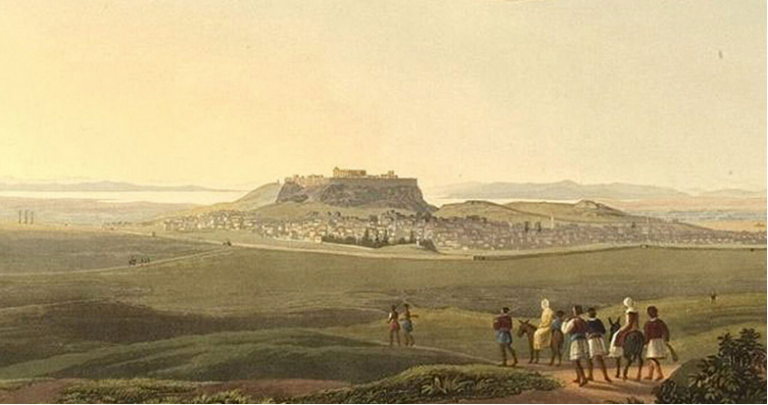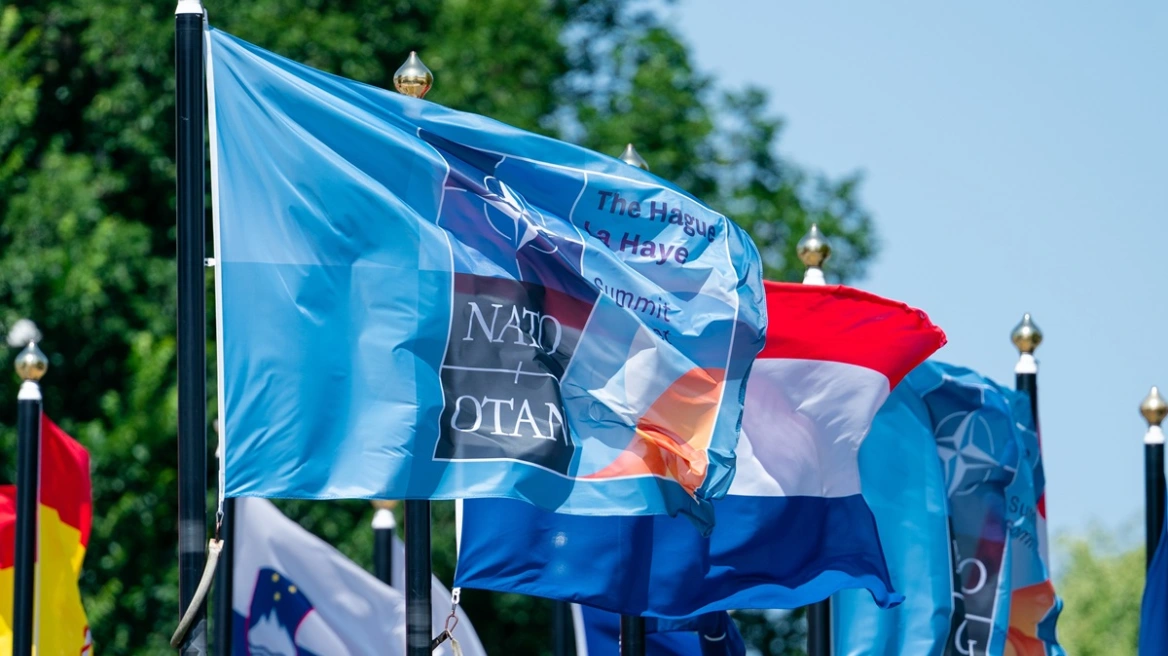We have written many articles on protothema.gr about the Revolution of 1821, its beginnings and its most important battles. In order not to return to topics that we have almost exhausted, we thought we would refer to the outbreak of the Revolution in Athens in 1821. Usually, great weight is given to the events of March 1821 in the Peloponnese and it is almost unknown to most people how the Struggle of 1821 began in Athens. Let us only note that our today’s tribute does not have any “Athens-centric” mood. After all, it is known to those who read our articles even occasionally that at times we have dealt with the whole of Greece, from Othoni to Evros and from Kastellorizo to Gavdos. Concluding this brief introduction, we mention that the celebration of the Greek Revolution of 1821, on March 25, began in 1838 with a Royal Decree of Otto.
Athens during the Turkish occupation
Athens was captured by the Ottomans in 1456, while the Acropolis in 1458. In the same year, Mehmed II, returning from the Peloponnese, visited Athens, the city admired by Western Europeans, and granted it some “privileges”, the most important of which were the following: its exemption from the jurisdiction of the Pasha of Evripos (Evia) and its subordination to the sultan’s harem, which he supervised himself with the chief eunuch and with the right of local self-government, specifically 12 elders (proestos, notables), who were always elected from the same families. In fact, they were the only ones in the entire enslaved Greece to have the double-headed eagle as their emblem.
During the difficult and dark years of Turkish rule, the Greek flame remained unquenched in the souls of the Athenians, among whom there were many who, after receiving the education they received in their homeland, studied in Italy and occupied important positions in the world of Greek intellectuals, such as Angelos Benizelos, Francis Ioannis Trimis, Theophilos Korydalleus, Leonardo Filaras, who attempted to organize a revolution with the help of the Europeans, Panagiotis Kodrikas, the eminent Indologist Dimitrios Galanos, whom we referred to in more detail in our article on Lake Roopkud, etc.
A special place among the Athenian women of the Turkish occupation is undoubtedly held by Philothei Benizelou, Saint Philothei the Athenian. The most important events in Athens during the Ottoman rule were the capture of the city by the Venetian Cappelo during the Venetian-Turkish War (1463-1475), which did not lead to the capture of the Acropolis, the terrible epidemic of 1522-1523, one of many that struck the city, the settlement of Arvanites in the remote agricultural areas far from Athens, the brief occupation of the city by the Venetians of Morosini in 1687, who caused enormous destruction to the Parthenon, seized the lions of the Acropolis, Thisseion and Piraeus (Porto Leone or Porto Drako was its name at that time) and withdrew from Athens at the end of 1687, leaving the city’s residents who had helped him at the mercy of the Turks.
The Athenians abandoned their city, which was deserted. They took refuge in Constantinople, Asia Minor, the Venetian possessions in the Morea and the Ionian Islands, and the islands neighboring Athens (Aegina and Salamis). With the mediation of the Ecumenical Patriarchate in 1691, the Athenians began to return to the city, but many never returned, despite the fact that the Turks did not create problems for those who returned. The years 1775-1795 were painful for Athens, when its voivode was the Orientalist Hadji Ali Agas Haseki, who was a servant of Sultan Selim III in his sarai in Constantinople, but became the lover of Esme Sultana, Selim’s sister, who bought the “malikiane” of Athens and gave it to Haseki. Haseki’s 20 years in Athens were perhaps the hardest not only for the city, but for any Turkish-occupied Greek region. In 1778 Haseki, at the head of a body of Turks and Greeks, repelled an Albanian attack from Thebes or Kalamos, while a little later he prevented a new raid of 6,000 Albanians under Maxout Bouloumbasis, ransoming the leader of the Albanians. The miserable living conditions of the Athenians during the time of Haseki resulted in epidemics and the death of many of its inhabitants. The most painful of all was the epidemic of 1789, when 1,500 Athenians lost their lives…
Athens shortly before the Revolution of 1821
Athens had 10,000 – 12,000 inhabitants in the years before 1821. Among them were 400 Turkish families. Haseki had fortified it with a “Wall”, the construction of which, according to Panagios Skouzes, cost 42,000 groschen, which the Athenians paid for. Those who did not give money for the “Wall”, which was built for protection from the continuous Albanian raids, were mercilessly beaten and imprisoned by the organs of the tyrant Haseki. As the French traveler Sponn writes, “the Athenians, who have always loved freedom,” saw their city spiritually reborn shortly before the Revolution of 1821 through the “Philomousson Society.” This was not a revolutionary society. It aimed at establishing and maintaining educational institutions, collecting and preserving antiquities in museums, as until then any foreigner who visited Athens, even prominent travelers like Sponn, whom we mentioned, took back to their homelands parts of its innumerable ancient monuments. The “Philomousson Society” also aimed at sending worthy but poor young people to study abroad. The moral and financial support of the “Philomousos Society” was undertaken by the first and greatest leader of modern Greece, Ioannis Kapodistrias, who in a letter to A. Vassiliou, who directed the Society’s office created in Vienna for the registration of subscribers, wrote the following: “Certainly you feel, as much as we do, the feeling that animates us in a memorable moment, during which (during which) we are obliged to the most sacred duty to the fatherland. For through it we exist and for it we owe our lives.” The “Philomousos Society” founded a School in Athens, which it intended to transform into a School with a university character. However, while the preparations had begun, the suspicions of the Turks about the purposes of such a School thwarted its operation for fear of possible persecution. The first revolutionary news caused concern among the Athenians, who were forced to wait until the revolution reached Attica. The revolutionary mood possessed everyone, rulers and people, as it turned out after a few days. However, in the other cities the revolution “came” from the countryside. In Athens and in Attica in general, there were no chieftains. Armatoliki was also impossible to exist, as the mountains of Attica, Parnitha, Penteli and Hymettus did not offer safe havens for outlaws, so that bodies of “security guards” in the countryside could be organized. In Athens, things were perhaps more difficult than in any other city. In addition to the Acropolis, where there was artillery, there was the “Wall” of Haseki. Only Athens and Tripolitsa had walls out of all the cities in Greece! The walls of Athens were not very high, but they certainly constituted an obstacle to anyone who wanted to attack, even without artillery. Athens at that time reached as far as today’s Stadiou and Ermou streets (!), today’s Evripidou street and Thiseio!
The Turks constituted 1/3 of the city’s population (families at that time were large). 500 Turks and Albanians were armed. Of these, 60 Albanians were gendarmes. It was therefore impossible to start the revolution from the city of Athens.
Meletis Vasiliou from Hassia starts the revolution in Attica
The…solution came from Hassia (Fyli). There, an intelligent, brave and patriotic peasant, Meletis Vasiliou had managed in the last year to organize, with the permission of the voivode of Athens, a small armed force. The Turks always allowed the locals to guard the dervenia, the narrow passages, where thieves almost always attacked those carrying goods. Vasiliou, who had been initiated into the Filiki Etaria, managed to have Hassia recognized as a “wooden village” and to form an armed body, not for the protection of his village, but for the revolution that he had learned would begin in the spring of 1821. However, there was another, initiated into the Filiki Etaria, the Menidiatis Anagnostis Kiourkakiotis, the most lively of all. He had come into contact with Vasiliou and gathered villagers from Menidi and other neighboring villages. Soon some from Salamis also arrived. Menidi was sworn in as a place of gathering and base.
The Turks in Athens had meanwhile panicked, as news began to arrive from the Peloponnese, Hydra and Spetses, as well as Livadia. At the same time, suspicious movements of villagers in Menidi were noticed. The mufti of Athens proposed the massacre of all Christian Athenians and most of the high-ranking Turkish officials of the city accepted it! However, Hadji Halil efentis, the kadis (judge) of Athens, a just man, reacted by saying that such a thing would be inhumane.
Thus, it was decided to arrest the city’s dignitaries and clergy. Indeed, on April 10, 1821, Easter day, the three, for that year, archons of the city were arrested: Prokopios Benizelos, Palaiologos Benizelos and Angelos Gerontas, as well as the dignitaries and clergy who were found “on the run”. The hieromonks Philaretos Triantafyllis and Anthimos Agiotafitis and the abbots Angelos Benizelos, Ioannis Pantazis, Georgios Barbanos, Dimitrios Karoris, Philippos Gounarakis, S.F. Gounarakis and Vasilios Sarantis. The Archbishop of Athens Dionysios was also sought, but he was absent in Livadia.
The arrested were taken to the Acropolis, imprisoned in miserable conditions and held as hostages. The remaining dignitaries found refuge in the consulates of European countries, where they were protected. Most important of all was the help of the consul of the Kingdom of Naples, Caesar Vitalis. Vitalis was a doctor, lived in the city for years, had married an Athenian and until his death in 1827, collaborated with the prominent people of Athens for its liberation.
Instead of the imprisonment of the prominent people scaring the Athenians, it had the opposite effect. Residents of the city came to an agreement with those who had gathered in Menidi and joined them. The help offered at that time by Georgantas and Panagis Skouzes, who were initiated into the Filiki Eteria, was significant. Panagis had purchased several rifles, which he had paid for himself and which were transported by a Dutch frigate. Dimitrios Zografos, a fiery patriot with great influence in many villages, incited other villagers to revolt. Skouze’s weapons were transported to Menidi. Vitalis took care to supply the armed men with gunpowder, which, as D. Kokkinos writes, was transported in tsotres (wooden wine containers).
The Friendly Dimos Antoniou arrives in Attica
M. Vasiliou decided to start the action. On April 18, 1821, some of his men beat a few Turks from Evia who had landed there after the Livadia revolution in Kalamos to spy on the movements of the Greeks in Attica. However, since among those gathered in Menidi, there was no one with military experience, Livadia requested that someone be sent to take over the leadership.
In fact, the well-known catechist of the Society, Dimos Antoniou, was sent. He arrived at Menidi wearing a helmet and epaulettes, like the dragoons of the European armies. Papaflessas in Messinia, Antonios Pelopidas in Triphylia and the Kefalonian Vafiopoulos in Corinth had appeared with helmets at the beginning of the Revolution. The villagers were impressed by Antonio’s attire and tried to imitate him. As there were no helmets, they wore mats and whatever else was available and could make an impression. Antonio, although not a man of arms, knew the military organization of Alexander Ypsilantis and trained his body by appointing centurions, pentikontarchs and ekisipentarchs. The Turks of Athens were now informed of the threatening gathering of Menidi and sent horsemen to scout.
The horsemen saw the rebels and returned, threatening a general massacre. They even raised the war flag at the command post as a slogan for a general uprising in arms. But the Muslims of Athens, who were already seized by terror, not only did not take up arms, but rushed with their families to the Acropolis for protection.
On the night of April 25, 1821, the rebels set out from Menidi. According to Sourmeli, there were approximately 1,200. The Hasiotes were led by Meleti Vasiliou and Dimitrios Sklias, the Menidiates by Anagnostis Kiourkakiotis and those coming from the Mesogeia by Ioannis Davaris. The Athenians who had rushed to Menidi were led by: I. Vlachos, N. Sarris, S. Zacharitsa, S. Vouzikis, D. Xanthi, S. Kyriakos, A. Korthinos, N. Kordas, Neroutso Benizelos, L. Nikas, and A. Poulos. The general leader was Antoniou and his adjutant was N. Kolovos. This crowd with their strange costumes and strange weapons, as those who did not have weapons were the majority, holding clubs and raised spears, arrived in front of the walls shouting and looking for a way to enter the interior of the city. The walls had seven gates: the Arvanitiki, to the south, the Vasilopoula, to Hadrian’s Gate, the Boubounistra, in today’s Syntagma Square, the Gate of the Holy Apostles, the Gyptiki to the west, the Mantravili, to the southwest, and the Castle Gate. Some jumped inside the wall from a point between the Gates of Boubounistra and the Gates of the Holy Apostles. Demetrios (Mitros) Sarkoudinos entered first, followed by Georgios Kourtesis. Although unarmed, he attacked a Turkish guard, disarmed him and killed him with his own sword. A Gate (D. Kokkinos does not specify which one) opened and the rebels entered the city. They killed the few guards and scattered throughout it, shouting: “Christ is Risen! Freedom!” Some Turks in the city were killed, while 36, including women and children, managed to flee to the Acropolis and were saved. The Greeks gave a eulogy for the blessing of the weapons and raised the flag of the revolution at the command post. The Turks were preparing to defend themselves in the Acropolis fortress.
However, when they saw some “Europeanized” people among the revolutionaries, they thought that the Europeans had sent aid to the rebellious Greeks. They turned to the European consuls, who assured them that this was not the case. Learning everything, the Greeks provided animals and rode around the Acropolis on horseback to the sounds of drums and the trumpets of the leading trumpeters. The Turks, seeing a strange crowd, among which there were some who had epaulettes or metal objects as insignia, began to laugh, considering the spectacle comical. One of them, addressing the Greeks, said:
-“What has happened to you, you people, that you have become like madmen? Has God taken your minds away so that you may perish?” However, the rebels were possessed by a sacred emotion. Shortly before, they had captured the city of Athens, which for the first time since 1456 (after 365 years!) was under question and they were besieging the city’s fortress, ready for any trial and sacrifice. Aeginetans, Ionians with a few cannons, Kythnians and Tziotes (from Kea) rushed to the aid of the Athenians, led by Pangalos (D. Kokkinos does not mention his name). The Hydraeans sent an 11-gun ship to Athens, led by Georgios Negas. An executive five-member committee was appointed for the administration of Athens, under the Archbishop of Athens Dionysios, Hatzis – Panagis Zacharitsas, Spyros Patousa, Archimandrite Demetrios Antonopoulos and Nikolaos Tyrnovitis, who were named deputies. Within ten days, the Turkish besiegers reached 3,000.
This was the account of the events of the first siege of Athens. Let us note for two of its protagonists that Mitros Sarkoudinos distinguished himself in the second siege of Athens, when he managed to jump the wall in the area of Serpentze (today the Odeon of Herodes Atticus) and opened the Mesogeion Gate, while the pioneer of the rebellion, Meletis Vasiliou, was murdered in 1826 by the prominent people who did not like him. However, his two brothers, Antonios and Ioannis, continued to fight under the orders of Georgios Karaiskakis…
Source: DIONYSIOS KOKKINOS, “THE GREEK REVOLUTION”, 6th edition, MELISSA PUBLISHINGS.
Ask me anything
Explore related questions





